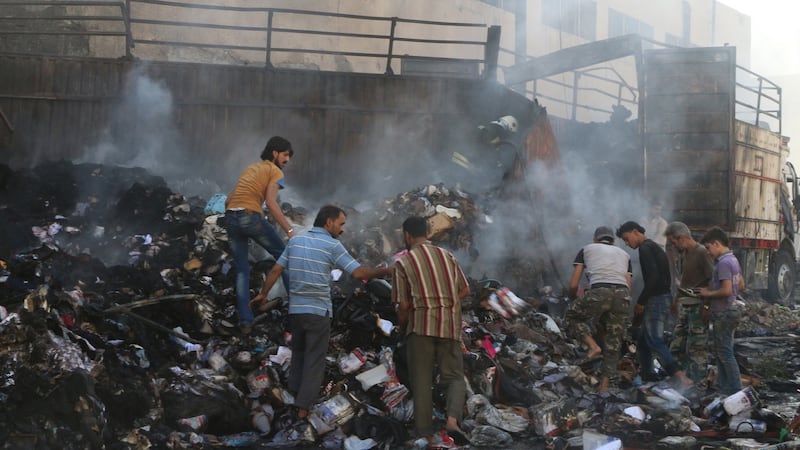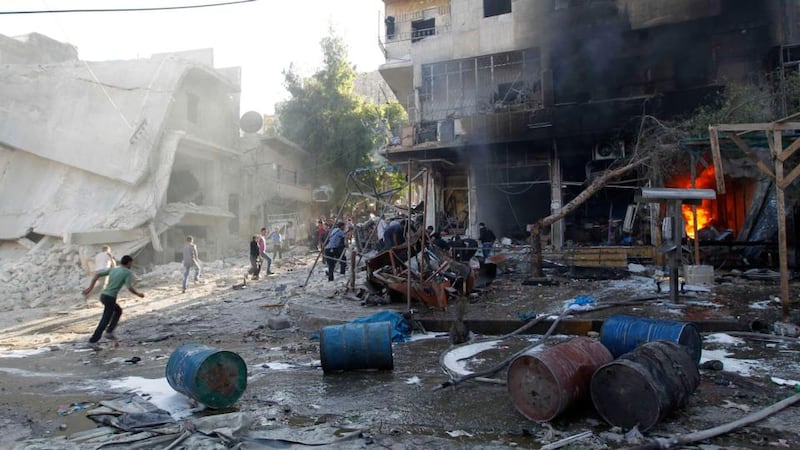The 20-storey Chahba Palace Hotel in western Aleppo is besieged by civilians on foot and in cars, the parking lot is gridlocked. Men, women, and children brave the security scan at the door and enter pandemonium.
Not the crush and confusion of revolution but of the 15th annual three-day festival marking International Women's Day staged by the women's committee of the Aleppo chamber of commerce. Committee member Alia Ajjan tells The Irish Times more than 6,000 come every day, surging into the bazaar set up in the hotel's public spaces. Children with painted faces brandish face masks on sticks and balloons. Carefully coiffed women in tailored suits greet friends enveloped in black cloaks. "We have people from all backgrounds here. Our aim is to convince women to take part in business," says Ajjan.
Before the war, Nawwaf Makhoul sold cosmetics near the Omayyad Mosque, known as the 'Big Mosque'. The shop was hit by an insurgent bomb made from a gas cylinder
Most of the 300 stalls are tended by women, a few who had shops in the ancient souq bombed and blasted in the six-year war between government and insurgents.
Ruba Manafikhi is selling embroidered linen and other handicrafts. She lost her shop while her husband lost two shops and a clothing factory. “They are under the rubble,” she says. Fortunately, her husband still has a shop in the western sector where she sells her goods.
Carpets and loom
Men whose shops have been destroyed also take advantage of the fete to display their wares.
Omar Rawas has carpets and a small loom.
“I make appointments to show my carpets by phone,” he says.
Before the war, Nawwaf Makhoul sold cosmetics near the Omayyad Mosque, known as the “Big Mosque”. The shop was hit by an insurgent bomb made from a gas cylinder.
“I lost everything and the owner of the shop wants it back. I have no new shop but I attend bazaars.” He, his wife and five-year old child receive some support from the Greek Orthodox church. Before the war Aleppo’s Christians comprised 13 per cent of the city’s inhabitants, but thousands have left since the conflict began.
Restaurants and cafes are packed with custom despite the lack of electricity and mains water.
The university is in session, government offices operate normally, devout folk attend churches and mosques. But Aleppo's factories, the mainstay of Syria's industrial sector, have been destroyed or their machinery looted and exported to Turkey. Aleppo needs many years of stability to recover and rebuild.

Until armed factions allied to the opposition Free Syrian Army seized east Aleppo in July 2012, Aleppo was Syria's most populous city with 2.1 million inhabitants and main commercial hub. Its claim to be the oldest city in the world rivals that of Damascus.
Magnets for travellers
Before the war, both cities were magnets for travellers. For centuries Ottoman caravanserais, or inns, hosted traders and pilgrims. The first western-style hotels in Aleppo were built by the Mazloumian family in the latter half of the 19th century.
The survivor of their four hotels was the Baron, founded in 1911 to benefit from traffic on the Berlin-Baghdad railway.
Baron guests included Lawrence of Arabia, Mustafa Kemal Ataturk, US president Theodore Roosevelt, aviator Charles Lindberg, Russian astronaut Yuri Gagarin, author Agatha Christie and actress Julie Christie. Lawrence's bill remains on display in a glass case in the salon.
Roubina Mazloumian, widow of the pipe-smoking owner Armen, says that during the war the Baron sheltered refugee families; two remain.
“We had five mortars on the hotel. We had snipers. The roof and two front rooms were hit by rounds and shells. For six years no one bothered us. Soldiers at the army checkpoint would come and sit on our balcony . . . When the army liberated the eastern sector, it rained mortars and rockets from the east.”
During our tour of the hotel, she points out the room where King Faisal – who fought with Britain in the Arab revolt against the Ottoman Turks in World War I – proclaimed Syrian independence on March 8th, 1920.
Business is not good now, each tries to find a way to earn a new income
Syria, the first modern Arab state, was erased by colonial France that July.
Armenian legacy
Like the remaining 15-17,000 members of Aleppo’s once flourishing, 60,000-strong Armenian community, Mazloumian is determined to remain in the city.

Jirair Reisian, a leading figure and member of the Syrian parliament, points out over dinner in the Armenian Club, "The history of the Armenians in Aleppo does not begin with the genocide and deportation by the Ottomans" but in the first century AD. Armenian Christian pilgrims came to Aleppo during pilgrimages to Jerusalem. They stopped and stayed. Before the war, there were 80-85,000 Armenians in Syria.
"Some from Aleppo moved inside Syria, to the coastal cities, some went to Lebanon or to Armenia. but they did not emigrate for good. They keep their houses and belongings. They dream of the days they passed in Syria. Life outside is much more difficult socially and economically . . . Armenians are part of the [Syrian] people. Men serve in the army and we have martyrs.
“Armenians live in west Aleppo but had factories in the east. They are in business, the crafts and mechanical professions. Business is not good now, each tries to find a way to earn a new income.”
In spite of economic difficulties, people cherish cultural life. The chamber music department of the music conservatory of Aleppo is staging a concert of baroque music in April.
Reisian, a British-trained optometrist, who heads this department, will play the recorder.











